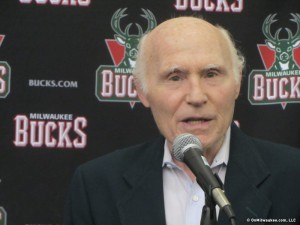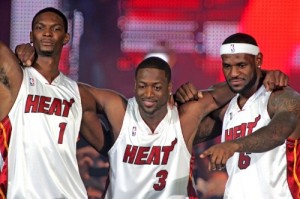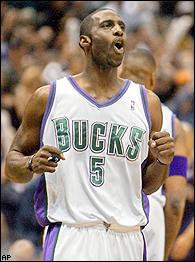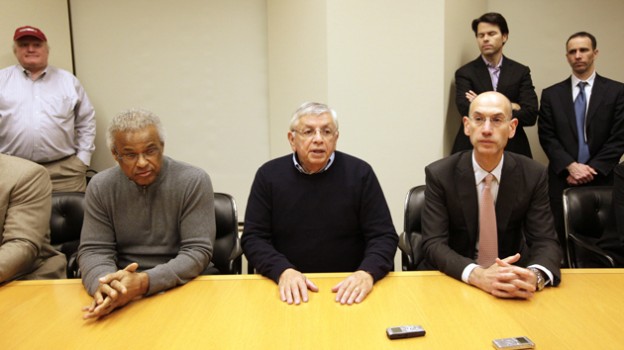FOLLOW US ON TWITTER @SaveOurBucks
Are the Bucks saved yet? Not quite. We’ve still got that messy arena project ahead of us. Only when the new arena is underway can we relax under the assumption the team is then locked into Milwaukee for the long-haul.
That said, it has become evident to us over the past week that when fans and NBA historians will look back at what saved the Bucks, the answer will be clear: The turning point was the 2011 Collective Bargaining Agreement (“CBA”) between the players union and the owners that came about as a result of the lockout.
Senator Kohl and his staff were critical players behind the scenes in the negotiation of this agreement, primarily as it relates to how small markets are treated. Did the small markets get everything they wanted with the 2011 CBA? No, but it becomes clearer by the day they got enough, as evidenced by LeBron James decision to return to small-market Cleveland. Let’s discuss!
The Revenue Changes made the Bucks Attractive to Buyers
We will try to keep this article brief and not get too technical. Two major changes occurred with the 2011 CBA in relation to revenues. The players reduced their guaranteed share of Basketball Related Income (“BRI”) to a range of 49-51%, down from the 57% they had been receiving under the prior CBA. This moved over to the owners side of the ledger significantly more cash from operations. The second change was the much improved revenue sharing for smaller markets, whereby estimated dollars available for revenue sharing jumped from a paltry $40 million in aggregate per season before the new CBA, to a projected $231 million shared with smaller market clubs for the 2013-14 fiscal year. While the new CBA was adopted in December of 2011, many of these important provisions, including the enhanced revenue sharing, didn’t kick in until this past season, thus catching the casual fan off-guard as to how significant these changes have been.
The impact of these changes have produced a profitable revenue outlook for the Bucks. Per Zach Lowe, the Bucks last year received approximately $18 million in revenue sharing dollars, which combined with $3 million in luxury tax revenue sharing payments allowed the Bucks to reportedly post a $14.8 million dollar profit. This type of profitability was not possible before the new 2011 CBA. It is the primary reason why so many potential bidders made efforts to purchase the Bucks when they went up for sale.
 As Kohl marketed the team to prospective buyers last winter, he was able to share with them the new financial reality that was taking place on the team’s income statement for the fiscal year ending June 30, 2014. These changes courtesy of the new CBA should allow the Bucks to run a competitive $60-75 million dollar payroll annually and still maintain an acceptable bottom line.
As Kohl marketed the team to prospective buyers last winter, he was able to share with them the new financial reality that was taking place on the team’s income statement for the fiscal year ending June 30, 2014. These changes courtesy of the new CBA should allow the Bucks to run a competitive $60-75 million dollar payroll annually and still maintain an acceptable bottom line.
Without these changes courtesy of the 2011 CBA, there likely is no Edens & Lasry ownership group coming in to take over the team and agreeing to keep it here in Milwaukee. We can’t understate how important those new revenue provisions were in “saving” the Bucks. And as the late TV pitchman Billy Mays used to say “But wait! There’s more!”
The New CBA is Working to Prevent Super Teams
One of the goals of the 2011 CBA was to prevent the big-markets from assembling super teams as the Heat had done the year prior with LeBron James, Dwayne Wade and Chris Bosh. What good is it for a small market like Milwaukee to develop talented young players, only to lose them later to free agency? Or for the small market teams to constantly have to face high-payroll, large market super teams?
The small markets initially wanted a hard salary cap and franchise player tag similar to what the NFL has had in place for years to solve issues of competitive balance. The players and large market franchises did not allow such drastic steps to be implemented. Nonetheless, the 2011 CBA did provide the following key features which are having an impact in allowing small market teams to retain their players and acting as a material speed-bump on the super teams:
–> The new CBA instituted a very punitive luxury tax system. Essentially if your club’s payroll is over the luxury tax threshold, your team will pay and pay and pay. Per the Lowe article referenced earlier, the massive Nets 2013-14 payroll generated a luxury tax bill of $90 million for last season alone. Few teams can handle this type of tax, and most have been reducing their payrolls over the last two years to avoid the tax. For the time being, the luxury tax is acting as a somewhat of a hard salary cap. To wit, billionaire Miami Heat owner Mickey Arison elected last year to amnesty (waive) Mike Miller, saving Arison an estimated $17 million dollar luxury tax bill related to Miller. More on this below.
–> The new CBA prevented teams with high payrolls over the luxury tax from being able to offer full Mid-Level Exception (MLE) contracts to free agents. Again, without getting too technical, what this rule essentially did was restrict teams running payrolls slightly above the luxury tax level from offering a full MLE contract of 4-years/$22 million total to free agents. Instead teams running these higher payrolls had to limit their MLE contract offers to a 3-years/$9 million total. This provision has had the effect of preventing teams like the Heat from getting better quality talent to support their “Big Three.” For many middle-class NBA veterans, they are not able to leave potentially $13 million ($22mm-$9mm) on the table just for the privilege of playing with LeBron.
–> The new CBA prevented teams from being able to “sign and trade” their own free agents using the contract they could grant as the incumbent club. Under the CBA, the Knicks are able to offer their own free agent, Carmelo Anthony, a five-year contract worth a total of $129 million dollars. Any team trying to lure him away can only offer a four-year contract worth $97 million dollars. If Carmelo wants to leave New York, he has to give up approximately $32 million in guaranteed money. Even for a high profile player such as Carmelo, this is a lot of coin so to speak.
If Carmelo wants to leave New York, he has to give up approximately $32 million in guaranteed money. Even for a high profile player such as Carmelo, this is a lot of coin so to speak.
The CBA rule allowing the incumbent team the ability to offer a larger and longer contract to their own free agents was enacted many years ago to help small market teams retain their players. The idea being that players would leave a lot of extra money on the table if they decided to bolt, thus incentivizing them to stay with their existing (presumably small market) clubs.
However there was a problem with this provision. In prior years, the player in question was allowed to sign the more lucrative five-year deal and then be immediately traded to a different club, while retaining the more lucrative contract. A couple years back, players such as LeBron, Chris Paul, Dwight Howard and many others had the ability to use this loophole to obtain the maximum allowable contract amount from their current club, while at the same time forcing their way to a different club under a sign and trade. The new CBA eliminated this loophole by requiring that any player traded under a sign and trade is only allowed to get the same four-year contract the acquiring club could have offered. This new limitation was part of the 2011 CBA but became effective only last year.
If this new limitation had not been in place, it is likely that Carmelo would have obtained his $129 million dollar contract that only the Knicks were eligible to offer him, while forcing his way to Chicago, Miami or LA via a sign and trade. That is no longer allowed. If a star player such as Carmelo wants to leave his existing team, he’s going to leave significant dollars ($32 million in Carmelo’s case) in guaranteed money behind. This new CBA provision will be important for the Bucks at the time their young talent such as Jabari Parker needs to negotiate his first contract extension with the team.
 And all of these provisions are playing themselves out right now with the Miami Heat. As Heat fans see their dynasty team broken up and wonder what went wrong, the answer is clear. It is the new 2011 CBA. The Heat have to pay so much money to their big three that they have little extra operating room to acquire or pay for other players under these new rules. Thus LeBron James didn’t have Kyle Lowry or Marcin Gortat joining him in Miami this month. The best Pat Riley could do under these new rules was acquire Josh McRoberts and a broken down “Lt. Dan” Granger. And all the talk about Carmelo joining the Heat? A non-starter as Carmelo can’t walk away from that extra $32 million we referenced above.
And all of these provisions are playing themselves out right now with the Miami Heat. As Heat fans see their dynasty team broken up and wonder what went wrong, the answer is clear. It is the new 2011 CBA. The Heat have to pay so much money to their big three that they have little extra operating room to acquire or pay for other players under these new rules. Thus LeBron James didn’t have Kyle Lowry or Marcin Gortat joining him in Miami this month. The best Pat Riley could do under these new rules was acquire Josh McRoberts and a broken down “Lt. Dan” Granger. And all the talk about Carmelo joining the Heat? A non-starter as Carmelo can’t walk away from that extra $32 million we referenced above.
Under the prior CBA, there were all sorts of loopholes that would have allowed Riley to keep that Heat team together and add additional real talent. That no longer is allowed. And this is before we get to the newly enacted punitive luxury tax, which forced Heat Owner Mickey Arison to jettison LeBron favorites Joel Anthony and Mike Miller last year. Some members of James camp contend that James was troubled by the fact the Heat were not willing to pay significant luxury tax penalties to keep Miller last season.
As you read LeBron’s letter citing his desire to go back home to Cleveland, realize that the real reason he’s leaving is he knows his Heat team was on the decline and Riley had little ability to improve it due to the changes from the 2011 CBA now taking effect.
The New CBA Limits “Mistakes”
The 2011 CBA not only reduced the MLE amount down from 5-years and $32 million (think Drew Gooden’s 2010 contract) to 4-years/$22 million, but it also reduced the length of all player contracts to four years if a free agent, and only five years for a team re-signing their own player. Further, the annual raise allowed under new contracts is down from 10.5% to 7.5% for a team’s own free agent and down from 8.0% annual raises to only 4.5% annual raises for free agents from another team.
In the past, those longer contracts and higher annual raises really added up. By way of example, had these new limits been in place in 2005, Michael Redd could only have obtained a 5-year/$69 million dollar contract from Milwaukee versus the 6-year/$90 million he received. Small markets like Milwaukee do not have unlimited funds. If the Bucks make a mistake on a player contract, they can’t afford to eat that contract and keep signing other players as large market clubs are more able to do.
 We all saw this problem play out over the past decade. Think of the 6-year/$72 million Tim Thomas contract or $90 million dollar Redd contract noted above. Those deals buried the team, and that is before we get to the lower dollar mistakes such as Gooden’s 5-yr/$32 million, Dan Gadzuric’s 6-yr/$36 million or Bobby Simmons 5-yr/$47 million. Can the Bucks and other small market teams still make serious contract mistakes? Certainly, but the consequences are much less as these contracts are now for lower total dollar amounts and burn-off faster.
We all saw this problem play out over the past decade. Think of the 6-year/$72 million Tim Thomas contract or $90 million dollar Redd contract noted above. Those deals buried the team, and that is before we get to the lower dollar mistakes such as Gooden’s 5-yr/$32 million, Dan Gadzuric’s 6-yr/$36 million or Bobby Simmons 5-yr/$47 million. Can the Bucks and other small market teams still make serious contract mistakes? Certainly, but the consequences are much less as these contracts are now for lower total dollar amounts and burn-off faster.
Those six (and seven) year contracts under prior CBA’s would bury the small market teams, however the Milwaukee’s of the world had to extend these large contracts out to players, because all the other large revenue clubs were doing so. You couldn’t retain or attract players otherwise.
While some of you may raise an eyebrow at the 4-year/$63 million offer sheet made to Gordon Hayward, that might have been a 6-year/$90 million contract event under the old CBA. Further, the lower MLE contract under the new CBA has reaped benefits already for the Bucks. Think back to when Luc Richard Mbah A’Moute was a free agent in 2011. All Denver could present to him in the way of an offer sheet was a four-year/$19 million dollar offer, which the Bucks matched. The Moute situation didn’t work out that well, but his contract wasn’t a disaster and was easily moveable. Think back to the prior years when Moute-like role players such as Etan Thomas and Brian Cardinal received 6-year/$40 million dollar deals under the previous MLE provision. Those contracts were disasters, however, MLE contracts of that size and length are no longer allowed under the 2011 CBA.
Are these new contract limits in the 2011 CBA somewhat saving the owners from themselves? Why, yes, it is having that effect. But it also is saving a small market team like the Bucks, because they no longer have to take as many significant risks with player contracts like they did in the past. Further, the league is better served because deserving young players like Chandler Parsons, Eric Bledsoe and Gordon Hayward will now receive big money for a shorter period of time, unlike years past where players like Tim Thomas and Brian Cardinal would be depleting the payroll for many more years and dollars after it was abundantly clear they weren’t living up to their deals. This should have the impact of incentivizing the players to perform at a higher level since they now have less guaranteed money available to them. Players such as Channing Frye may not prove to be worth the 4-year/$32 million dollar contract he just signed with Orlando, but if that occurs, their money will be recirculated to new players much more quickly.
Summary
The 2011 CBA wasn’t a slam dunk win for small markets, as the NBA’s CBA structure still isn’t as favorable as what the Packers have in the NFL, nonetheless, it was the pivotal moment that allowed the team and Bucks fans to reach to point of optimism we are at today. The Bucks are profitable, have better ability to retain their star players in the future and the big market super-team structure while not eliminated, has been somewhat neutralized.
We owe this all to the small-market owners, including Senator Kohl who endured the 2011 lockout, working behind the scenes to make this new CBA a reality. So as free agency continues to play out this summer, let’s enjoy our bright future ahead. For now the system is working, and it is benefiting the Milwaukee greatly.
Go Bucks!
 Reminder – Viewing Party for Jabari’s Summer League Debut!
Reminder – Viewing Party for Jabari’s Summer League Debut!
WHEN: Friday, July 11th at 7:00pm CST
WHERE: Major Goolsby’s: 340 W Kilbourn Ave, Milwaukee, WI 53203
(414) 271-3414
WHY: BUCKS VS CAVS Summer League, Jabari vs Wiggins
Get more details here on our FACEBOOK Party Page

